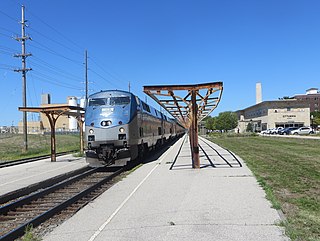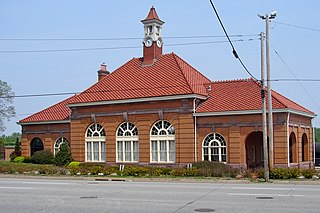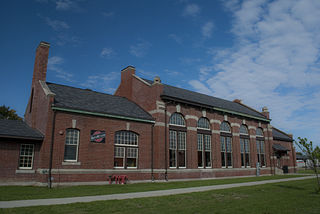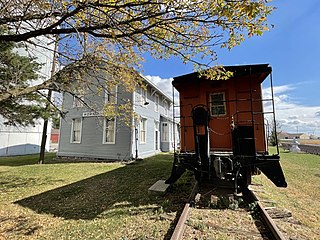
Ottumwa station is an Amtrak intercity train station in Ottumwa, Iowa, United States. The station was originally built by the Chicago, Burlington and Quincy Railroad, and has been listed as Burlington Depot by the National Register of Historic Places since November 26, 2008. It became a contributing property in the Historic Railroad District in 2011.

West Concord station is an MBTA Commuter Rail station located in West Concord, Massachusetts. It is served by the Fitchburg Line. The station has two side platforms serving the line's two tracks, with mini-high platforms for accessibility. The adjacent station building, now a restaurant, is not used for railroad purposes.

The Atchison, Topeka and Santa Fe Passenger and Freight Complex is a nationally recognized historic district located in Fort Madison, Iowa, United States. It was listed on the National Register of Historic Places in 1992. At the time of its nomination it contained three resources, all of which are contributing buildings. The buildings were constructed over a 24-year time period, and reflect the styles that were popular when they were built. The facility currently houses a local history museum, and after renovations a portion of it was converted back to a passenger train depot for Amtrak, which opened on December 15, 2021.

North Conway station is a railway station located in North Conway, New Hampshire. Built in 1874, the depot was designed by Nathaniel J. Bradlee in an eclectic Russian-Victorian style. The station is also the terminus for the Conway Scenic Railroad. Northwest of the station stands a roundhouse, which now houses the Scenic Railroad's rolling stock; it was built around the same time as the station. The yard and depot were added to the National Register of Historic Places in 1979 as North Conway Depot and Railroad Yard.

The Iron River depot was built by the Chicago, Milwaukee, St. Paul and Pacific Railroad—better known as the Milwaukee Road—in 1913. Located in Iron River, Michigan, the brick depot has a modified Neoclassical design and is rectangular in shape. The depot has a covered porch on one end that connected to the waiting room. The station agent's office was located in the middle of the building, and a freight room was on the other end.

El Garces Intermodal Transportation Facility is an Amtrak intercity rail station and bus depot in downtown Needles, California. The structure was originally built in 1908 as El Garces, a Harvey House and Atchison, Topeka and Santa Fe Railway (ATSF) station. It is named for Francisco Garcés, a Spanish missionary who surveyed the area in the 1770s. It was added to the National Register of Historic Places in 2002.

The Rock Island Lines Passenger Station, also known as Abbey Station, is a historic building located in Rock Island, Illinois, United States. It ceased operating as a railway station in 1980. The building was listed on the National Register of Historic Places in 1982, and it was designated a Rock Island landmark in 1987.
Frost & Granger was an American architectural partnership from 1898 to 1910 of brothers-in-law Charles Sumner Frost (1856–1931) and Alfred Hoyt Granger (1867–1939). Frost and Granger were known for their designs of train stations and terminals, including the now-demolished Chicago and North Western Terminal, in Chicago. The firm designed several residences in Hyde Park, Illinois, and many other buildings. Several of their buildings are listed on the U.S. National Register of Historic Places.

The Chicago and Northwestern Railroad Depot is a railroad station located between Suffolk and Lowell Streets in Ironwood, Michigan. It was listed on the National Register of Historic Places in 1985.
The Chicago and North Western Passenger Depot is a historic building located in Wall Lake, Iowa, United States. Wall Lake was served by both the Chicago & North Western Railroad and the Illinois Central Railroad, which gave it a significant rail presence from the 1880s until World War II. The C&NW depot is an example of a combination station plan. The plan combined both passenger and freight services in one building. They were commonly used during the heyday of railroad growth round the turn of the 20th century. However, the old Wall Lake C&NW depot was moved and used for freight. What would have been the freight room was used here for a lunchroom. C&NW had three standard combination depot plans that have been attributed to the prominent Chicago architectural firm of Frost & Granger. The Wall Lake depot was the largest of the three as it incorporated a women's waiting room, but it was actually 9 feet (2.7 m) shorter than the general plan because freight was processed in another facility. The depot was built in 1899 by A.H. Carter & Co. of Cedar Rapids, Iowa as a replacement depot. The single-story frame structure is the only building used as a depot that remains in town. It was listed on the National Register of Historic Places in 2003.

The Racine Depot is a historic railroad station located at 1402 Liberty Street in Racine, Wisconsin. The station was built in 1901 for the Chicago & North Western Railway. Architects Frost & Granger designed the Georgian Revival station. The depot, located on the southbound platform, included a waiting room, restrooms, a baggage room, and a ticket office. The waiting room's decorations included oak benches, wood paneling, and a terrazzo floor. A tunnel connected the depot to the westbound platform.

The St. Louis, Peoria and Northern Railroad Depot, previously known as the Pekin Depot or Chicago and Alton Depot, is a historic railroad station in Pekin, Illinois. The station is one of the only historic rail-related buildings remaining in Pekin.

The American Express Building-Carroll, also known as the Carroll Express Building is a historic structure located in Carroll, Iowa, United States. Like the Chicago & Northwestern Passenger Depot across the street, the express building is an example of a replacement station built during the Golden Age of Steam Railroading. It replaced a frame, structure that was built sometime between 1888 and 1893. The Chicago and North Western Railway (CNW) had built two branch lines from Carroll in 1877 and 1880, which increased business and necessitated the building of the original express building between 1883 and 1888. Chicago architect Charles Sumner Frost designed this building, and the depot. They are similar in design, and were both completed in 1896. The building was listed on the National Register of Historic Places in 1990.

The Chicago and North Western Office Building/Passenger Depot-Lake City, also known as the Lake City Depot, is a historic building located in Lake City, Iowa, United States. The Toledo & North Western Railroad (TNW) laid the first tracks through town in 1881–1882. Because Lake City was already established, they built a two-story, frame, combination depot and the southeast edge of town. Because of its convenient location, the TNW also built their repair and maintenance shops in Lake City in the 1880s. They placed their division headquarters here in 1887. The Chicago and North Western Railway (CNW) acquired controlling interest in the TNW in June 1881, and ran it separately until it formally acquired it in 1890.

The Rock Island Passenger Depot is a historic building located in Oskaloosa, Iowa, United States. The Chicago, Rock Island & Pacific Railroad arrived in town in 1876, and they built a frame combination depot on the north side of the tracks. This depot replaced the original one in 1888 on the south side of the tracks, and it served ten passenger trains a day. A separate freight depot was built to the east. President Theodore Roosevelt stopped here when he came to dedicate the new Y.M.C.A. in 1903. The freight and passenger depots were combined into a single facility once again in 1930, utilizing the passenger depot. The depot was officially abandoned in 1973. It was listed on the National Register of Historic Places in 1989. The building now houses a pub.

The Chicago, Rock Island and Pacific Railroad: Stuart Passenger Station is a historic building located in Stuart, Iowa, United States. The town of Stuart was laid out by Charles A. Stuart, for whom it is named, in concert with the Chicago, Rock Island and Pacific Railroad. The railroad reached this point in 1868 and the depot was completed the following year. It is a single story, side gable, frame structure covered with brick veneer. The segmentally-arched widows are capped with brick hoods and limestone keystones. It contains four rooms that housed a baggage room, men's waiting room, ticket office, and the ladies waiting room. This was one of several buildings constructed in Stuart by the Rock Island Line, which placed a divisional headquarters here from the beginning. Other facilities included a roundhouse (1871) and brick shops (1874) that replaced wood-frame structures. In 1897 the railroad moved its facilities to Valley Junction, now West Des Moines.

The Chicago, Milwaukee, St. Paul & Pacific Combination Depot-Hornick, also known as the Hornick Depot, is a historic building located in Hornick, Iowa, United States. The town was patted by the Chicago, Milwaukee, St. Paul & Pacific Railroad's land company when the railroad created a branch line from Manilla, Iowa to Sioux City. Completed in 1887, the railroad built this two-story frame structure to serve as its passenger and freight depot. It is one of six such depots that remain in Iowa, and the best preserved. These buildings were built from a standard design used by the railroad. The two-story stations included living quarters for the station manager because the towns had yet to develop when the depot was built. This was an island depot, with freight loaded on the north side and passengers boarded on the south. Decorative elements on this depot include lathe-turned wooden finials, angled wooden brackets, and bracketed door and window hoods. Passenger service ended in the 1950s, and grain was loaded here until 1980 when the Milwaukee Road abandoned the Sioux City branch line. The building was listed on the National Register of Historic Places in 1990. It has been converted into a local history museum.

The South Milwaukee Passenger Station is a historic railroad station located at 1111 Milwaukee Ave., South Milwaukee, Wisconsin. The station was built in 1893 for the Chicago & Northwestern Railway replacing a frame depot from 1885. Architect Charles Sumner Frost designed the Romanesque station. The depot, located on the east (southbound) platform, included ladies and gentlemen's waiting rooms, restrooms, a ticket office, freight office, train dispatcher's office, and two large rooms for baggage, express, and storage.

Madison station is a former railroad station in Madison, Wisconsin. The station served passenger and freight trains of the Chicago and North Western Railway (C&NW). Passenger service ended in 1965 and the passenger station and freight depot was bought by Madison Gas and Electric (MGE) and has been renovated to serve as offices. The station and freight depot are listed as contributing properties on the National Register of Historic Places East Wilson Street Historic District. The Chicago, Milwaukee, St. Paul and Pacific Railroad had tracks paralleling the C&NW and also had a nearby passenger station that outlasted the C&NW station as an active station by several years.

The Chicago and North Western Railway Depot was built by the Chicago and North Western Railway (C&NW) in 1914 at a cost of $38,000. It is located at the west end of the business district in Redfield, South Dakota. The depot is a long rectangular red brick building with a slate roof in an uncommon Gothic Revival style.





















